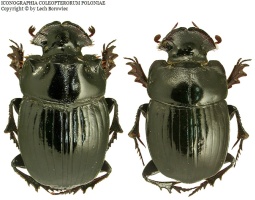
Русские, остановите эту войну! Спасите Свободную Украину!
Russians, stop this war! Save Free Ukraine!
Biodiversity Map
Taxa

Copris — subordinate taxa:
Taxon count: 1
-
Arthropodaphylum
Click to switch
to select orders
and filters > -
Hexapodasubphylum
Click to switch
to select orders
and filters > -
Insectaclass
Click to switch
to select orders
and filters > -
Coleopteraorder
Click to set
as the main taxon
and as a base
← of the left panel > -
Polyphagasuborder
Click to set
as the main taxon
and as a base
← of the left panel > -
Scarabaeiformiaseries
Click to set
as the main taxon
and as a base
← of the left panel > -
Scarabaeoideasuperfamily
Click to set
as the main taxon
and as a base
← of the left panel > -
Scarabaeidaefamily
Click to set
as the main taxon
and as a base
← of the left panel > -
Scarabaeinaesubfamily
Click to set
as the main taxon
and as a base
← of the left panel > -
Coprinitribe
Click to set
as the main taxon
and as a base
← of the left panel > -
Coprisgenus
Click to set
as the main taxon
and as a base
← of the left panel > -
Coprissubgenus
Click to set
as the main taxon
and as a base
← of the left panel >
PL
YES
name status: valid name
BioMap ID: 1013337
taxon code: 2403
taxonomy checked: YES
Polish Red List: NT
Data on distribution in Poland

Statistics
- Records: 167
- Publications: 57
- Collections: 11
- Publication authors: 51
- Illustrations (iconography): 1
- Photos (specimen/observation): 2
Taxon description
Gatunek rozpowszechniony głównie w Europie południowej oraz w ciepłych okolicach środkowej części Europy, na północ sięgający do Anglii, południowej Szwecji i okolic Oslo, a na wschód przez Azję Mniejszą i Iran do Chin. W Polsce prócz wysokich gór występuje w całym kraju na glebach piaszczystych i lessowych nasłonecznionych pastwisk pod świeżymi lub nieco przeschniętymi odchodami bydlęcymi i końskimi. Buduje komory ziemne gromadząc w nich pożywienie dla siebie i potomstwa. Po przezimowaniu pojawia się w maju, a nowa generacja ukazuje się w końcu lipca.
Illustrations
... browse
 Copris
Coprislunaris
External data sources
- Ostatnie rekordy
-
1115141
 ⊡
⊡ Scarabaeidae: Copris lunaris, PL, Wyżyna Małopolska, mazowieckie, Radom, Zakrzew, Nieczatów ad Zakrzew, UTM EB09, 2019, leg. M. Miłkowski
Scarabaeidae: Copris lunaris, PL, Wyżyna Małopolska, mazowieckie, Radom, Zakrzew, Nieczatów ad Zakrzew, UTM EB09, 2019, leg. M. Miłkowski -
1111398
 ⊡
⊡ Scarabaeidae: Copris lunaris, PL, Nizina Mazowiecka, Cztery Kopce, UTM EC31, 2004, leg. W. Piątek
Scarabaeidae: Copris lunaris, PL, Nizina Mazowiecka, Cztery Kopce, UTM EC31, 2004, leg. W. Piątek -
1110800
 ⊡
⊡ Scarabaeidae: Copris lunaris, PL, Wyżyna Lubelska, Wola Uhruska, UTM FB88, 2006, leg. P. Zięba
Scarabaeidae: Copris lunaris, PL, Wyżyna Lubelska, Wola Uhruska, UTM FB88, 2006, leg. P. Zięba -
1110799
 ⊡
⊡ Scarabaeidae: Copris lunaris, PL, Roztocze, Grodysławice, UTM FB80, 2011, leg. J. Mazepa
Scarabaeidae: Copris lunaris, PL, Roztocze, Grodysławice, UTM FB80, 2011, leg. J. Mazepa -
1092446
 ⊡
⊡ Scarabaeidae: Copris lunaris, PL, Pojezierze Mazurskie, Serwy, UTM FE47, 1987, leg. J. Siekierski
Scarabaeidae: Copris lunaris, PL, Pojezierze Mazurskie, Serwy, UTM FE47, 1987, leg. J. Siekierski -
1092445
 ⊡
⊡ Scarabaeidae: Copris lunaris, PL, Pojezierze Mazurskie, Suwałki, UTM FE29, 1988, leg. J. Siekierski
Scarabaeidae: Copris lunaris, PL, Pojezierze Mazurskie, Suwałki, UTM FE29, 1988, leg. J. Siekierski -
1074702
 ⊡
⊡ Scarabaeidae: Copris lunaris, IR, Golestān Forest, Golestān, ad Minudasht, 2015, leg. A. Lasoń
Scarabaeidae: Copris lunaris, IR, Golestān Forest, Golestān, ad Minudasht, 2015, leg. A. Lasoń -
1064921
 ⊡
⊡ Scarabaeidae: Copris lunaris, PL, Podlasie, Nizina Podlaska, podlaskie, wysokomazowiecki, Sokoły, Jeńki, UTM FD27, 2012, leg. A. Lasoń
Scarabaeidae: Copris lunaris, PL, Podlasie, Nizina Podlaska, podlaskie, wysokomazowiecki, Sokoły, Jeńki, UTM FD27, 2012, leg. A. Lasoń -
1000320
 ×
× Scarabaeidae: Copris lunaris, Wawer, 1934, coll. MiIZ PAN: Tenenbaum Sz.
Scarabaeidae: Copris lunaris, Wawer, 1934, coll. MiIZ PAN: Tenenbaum Sz. -
1000319
 ×
× Scarabaeidae: Copris lunaris, Dźwinogród, 1937, coll. MiIZ PAN: Tenenbaum Sz.
Scarabaeidae: Copris lunaris, Dźwinogród, 1937, coll. MiIZ PAN: Tenenbaum Sz. - ... more
- Powiązane publikacje
-
Pacuk B., Melke A., Kozłowski M.W. 2011. Nowe stanowiska Emus hirtus (Linnaeus, 1758) (Coleoptera: Staphylinidae: Staphylininae) w Polsce. Wiad. Entomol., 30(1):58-60 [549].
 full text
full text Show records
Show records -
Gawroński R., Oleksa A. 2007. Nowe stanowiska rzadkich i zagrożonych chrząszczy (Coleoptera) z północnej Polski. Wiad. Entomol., 26(1):5-14.
 full text
full text Show records
Show records -
Bidas M., Buchholz L. 2007. Interesujące chrząszcze (Coleoptera) stwierdzone w Górach Świętokrzyskich. Wiad. Entomol., 26(4):289-291 [463].
 full text
full text Show records
Show records -
Bunalski M. 2006. Żuki (Coleoptera: Scarabaeoidea) wschodnich rubieży Polski. Studium faunistyczno-ekologiczne części północnej i środkowej. Akademia Rolnicza im A. Cieszkowskiego w Poznaniu.
 Show records
Show records -
Bunalski M. 1999a. Die Blatthornkäfer Mitteleuropas (Coleoptera, Scarabaeoidea). Bestimmung – Verbreitung – Őkologie. Slamka Editions, Bratislava. 80 pp.
 Show records
Show records - ... more








